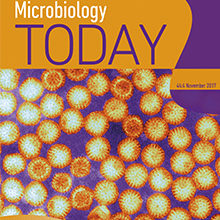November issue of Microbiology Today now online
08 November 2017

This November issue of Microbiology Today explores some of the ways microbiology has been presented in popular culture, from genetics to terraforming new planets. Microbiology in popular culture helps foster an understanding of science to generate dialogue and debate, and can be a source of inspiration for future microbiologists. It breaks down barriers to help people engage with science in an entertaining way, but may not always be reflective of what happens in reality and the lab.
Sandy Starr and Jennifer Willows discuss genome editing and the public perception of the topic in their article. Sandy and Jennifer reference Brave New World, Frankenstein and Gattaca, and how these fictional works can help engage the public with genome editing and raise ethical concerns central to views on the subject. Lorna Dawson and Chris Gannicliffe consider crime dramas, such as CSI. In their piece, Lorna and Chris focus on the representation of forensic science and the less glamorous situations many real-life forensic scientists find themselves in that are more time-consuming and abstract than shown on-screen.
Andrew M. Burns and David Bhella outline some of the many killer microbes presented in movies, and the likelihood of such scenarios taking place in the modern world and inside the lab. With reference to Outbreak, Contagion and 28 Days Later, Andrew and David explain that although the films may not be following the timelines of known diseases, they offer insight and make science understandable by introducing complex microbiological science. P. Lewis White outlines some of the ways fungi are represented in his article, referring to The Girl with All the Gifts, and the video game, The Last of Us, that show fungi turning people into zombie-like creatures. Lewis highlights that the less dramatic and less visual pervasive fungal diseases in circulation may be more potent than people realise.
Arwyn Edwards considers the terraforming of planets as presented in Star Trek's Genesis Device and Prime Directive, Star Wars: The Empire Strikes Back and the film, The Martian. Arwyn highlights how human survival on other planets is complex and considers how a terraforming microbiologist may go about making a planet hospitable for humans. The Comment piece from Amy C. Chambers, ‘Movies and scientific accuracy’, considers how the reality of science can often be more enthralling than what is made up. Amy outlines how science advisors and film-makers are increasingly working together to maintain scientific accuracy in movies while preserving the thrill and drama.
The issue also includes information on the 2017 Society Showcase and Annual General Meeting, the Multicoloured Microbiomes colouring book, ECM Forum update, the latest on our journals and more.
View the latest issue online.


